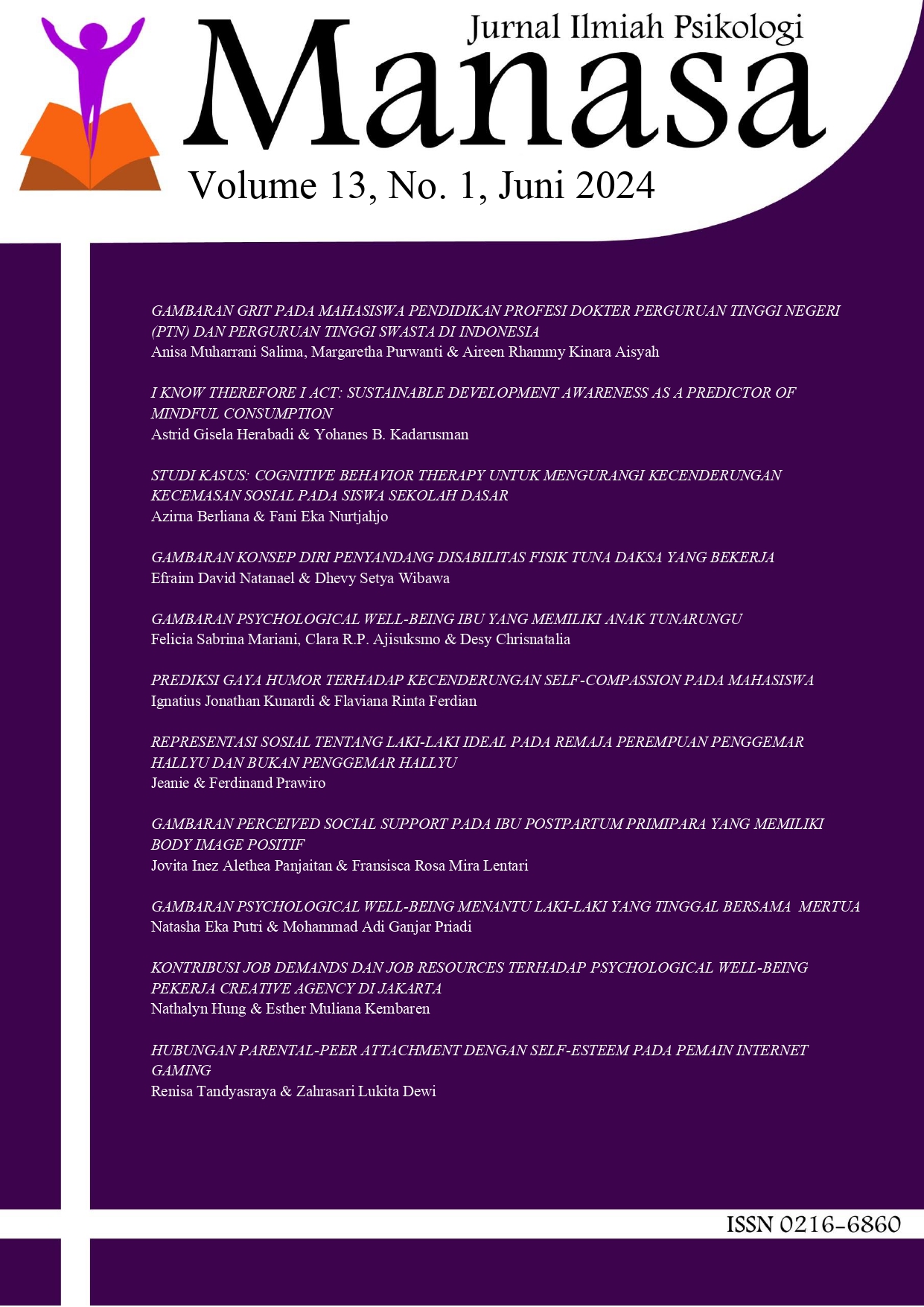STUDI KASUS: COGNITIVE BEHAVIOR THERAPY UNTUK MENGURANGI KECENDERUNGAN KECEMASAN SOSIAL PADA SISWA SEKOLAH DASAR
DOI:
https://doi.org/10.25170/manasa.v13i1.5551Keywords:
Social anxiety, elementary school students, cognitive behavior therapyAbstract
Excessive feelings of fear characterize students with social anxiety and worry and avoidance of social situations, especially in the school environment. Students quickly feel nervous and anxious when they are in a crowded environment or public place, such as avoiding appearing in front of the class, not daring to refuse or reprimand others, speaking in a low voice, not daring to answer or ask questions, not looking the other person in the eye, and being afraid. Others poorly view them. This case study involves a fifth-grade elementary school (Sekolah Dasar/SD) student who has experienced social anxiety for the past year. The subject feels uncomfortable in crowded places and has negative thoughts about other people's views of him. Assessment is carried out by observation, interviews, psychological tests (WISC, CSCT, graphic), and the Liebowitz social anxiety scale. The intervention provided to reduce social anxiety in subjects used a cognitive-behavioral approach, namely, Cognitive Behavior Therapy, carried out for nine sessions. The intervention results showed that the subjects could identify irrational thoughts and change them to be more rational, decreasing anxiety levels when appearing in front of the class and interacting with other people in the class and school environment according to the predetermined intervention targets.
References
American Psychiatric Association [APA]. (2013). Diagnostic and statistical manual of mental disorders: DSM-5 (Vol. 5, No. 5). American psychiatric association.
Asrori, A., & Hasanat, N. U. (2015). Terapi kognitif perilaku untuk mengatasi gangguan kecemasan sosial. Jurnal Ilmiah Psikologi Terapan, 3(1), 89-107. https://doi.org/10.22219/jipt.v3i1.2128
Beck, J. S. (2011). Cognitive behavior therapy basics and beyond second edition. The Guilford Press.
Brook, C. A., & Schmidt, L. A. (2008). Social anxiety disorder: A review of environmental risk factors. Neuropsychiatric disease and treatment, 4(1), 123-143. https://doi.org/10.2147/NDT.S1799
Clark, D. M., Ehlers, A., McManus, F., Hackmann, A., Fennell, M., Grey, N., Wild, J. (2006). Cognitive therapy versus exposure and applied relaxation in social phobia: A randomized controlled trial. Journal of Consulting and Clinical Psychology, 74(3), 568-578.
Corey, G. (2013). Teori dan praktek konseling dan psikoterapi. PT. Reka Aditama.
Ginsburg, G. S., La Greca, A. M., & Silverman, W. K. (1998). Social anxiety in children with anxiety disorders: Relation with social and emotional functioning. Journal of Abnormal Child Psychology, 26(3), 175–185. https://doi.org/10.1023/A:1022668101048
Henderson, L., & Zimbardo, P. (2010). Shyness, social anxiety, and social anxiety disorder. In Social anxiety, 65-92. https://doi.org/10.1016/B978-0-12-375096-9.00003-1
James, A., Soler, A., & Weatherall, R. (2005). Cognitive behavioural therapy for anxiety disorders in children and adolescents (review). Cochrane Database of Systematic Reviews, (4), 1-26.
Karp, J., & Dugas, M. J. (2003). Stuck behind a wall of fear (how cognitive behavior therapy helped women with social phobia. Journal of Clinical Case Studies, 2(3), 171-187. https://doi.org/10.1177/1534650103002003001
Kendall, P. C., Flannery-Schroeder, E., Panichelli-Mindel, S. M., Southam-Gerow, M., Henin, A., & Warman, M. (1997). Therapy for youths with anxiety disorders: A second randomized clinical trial. Journal of consulting and clinical psychology, 65(3), 366-380. https://doi.org/10.1037/0022-006X.65.3.366
La Greca, A. M., & Lopez, N. (1998). Social anxiety among adolescents: Linkages with peer relations and friendships. Journal of abnormal child psychology, 26(2), 83-94. https://doi.org/10.1023/A:1022684520514
Leigh, E., & Clark, D. M. (2016). Cognitive therapy for social anxiety disorder in adolescents: A development case series. Behavioural and Cognitive Psychotherapy, 44, 1-17.
Liebowitz, M. R. (1987). Social phobia. Mod. Prabl. Pharmacopsychiat, 22,141-173, https://doi.org/10.1159/000414022
Lowenstein, L. (2016). Creative cbt interventions for children with anxiety. Champion Press.
Nelson-Jones, R. (2011). Teori dan praktik konseling dan terapi. Pustaka Pelajar.
Pebriani, L. V. (2021). Korelasi antara self-compassion dengan kecemasan sosial pada anak usia sekolah dasar di kota bandung. Journal of Psychological Science and Profession, 5(1), 57-65. https://doi.org/10.24198/jpsp.v5i1.31931
Roth, D. A., Eng, W., & Heimberg, R. G. (2002). Cognitive behavior therapy. In Encyclopedia of Psychotherapy (pp. 761-768). USA: Elsevier Science.
Ryan, J. L., & Warner, C. M. (2012). Treating adolescents with social anxiety disorders in schools. Child Adolesc Psychiatr Clin N Am, 21(1), 105-110
Santrock, J. W. (2004). Life-span development: perkembangan masa hidup. Erlangga.
Schreiber, F., Hoing, V., Stangier, U., Bohn, C., & Steil, R. (2012). A cognitive model of social phobia: applicability in a large adolescent sample. International Journal of Cognitive Therapy, 5(3), 341-358.
Seligman, L. D., & Ollendick, T. H. (2011). Cognitive behavioral therapy for anxiety disorders in youth. Child Adolesc Psychiatr Clin N Am, 20(2), 217-238. https://doi.org/10.1016/j.chc.2011.01.003
Suryaningrum, C. (2005). Terapi kognitif-tingkah laku untuk mengatasi kecemasan sosial. Tesis. Jakarta: Pascasarjana Fakultas Psikologi Universitas Indonesia.
Downloads
Published
Issue
Section
License
Copyright (c) 2024 MANASA

This work is licensed under a Creative Commons Attribution-NonCommercial-ShareAlike 4.0 International License.









.png)
.png)

